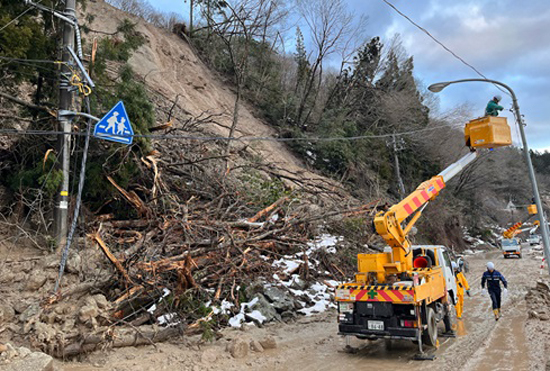NTT West Hokuriku explains the status of communication restoration after the Noto Peninsula earthquake

On June 25, NTT West Hokuriku explained the status of communication restoration and reconstruction after the Noto Peninsula earthquake.
To restore communications, the company responded with a team of up to about 950 people per day, including NTT West Japan Group, NTT Group, and communications construction companies. At the beginning of the disaster, up to about 8,000 fixed-line telephone lines and up to about 1,500 FLET’S Hikari lines were affected. Currently, these effects have been almost resolved, but in some areas of Wajima City, about 180 fixed-line telephone lines and about 50 FLET’S Hikari lines are still affected.
Immediately after the disaster, the communications building was not supplied with power, and the building experienced a power outage. To deal with the power outage, batteries were supplied, but there was a risk of the power running out due to the long-term outage, so mobile power supply vehicles were gathered from each prefecture in western Japan to respond. At the time, road conditions were poor, and it took three times longer than usual to travel from Kanazawa City to the site.
Currently, all of the telecommunications buildings have been restored, except for one building in an area that is difficult to access.
Many of the optical cables connecting the telecommunications buildings were cut due to landslides and road collapses, which had a major impact on telecommunications services. In response to these issues, cables that could be restored along the same route were repaired or partially replaced. Other than that, cables were restored along new detour routes. For example, cables were restored along a detour route near Nakaya Tunnel in Wajima City.
The on-site work had to be carried out amid aftershocks and falling snow, which made for very tough conditions. As mentioned above, the bad roads meant that travel times were three times longer than usual. Initially, it took about six hours one way to get to the site from Kanazawa City, and another six hours one way back to Kanazawa City. As a result, on-site work could only be done for about three hours. Therefore, efforts were made to free up as much work time as possible by setting up a frontline base in vacant space in the on-site telecommunications building and borrowing the gymnasium of Noto High School.
Using their frontline bases, they grasped the full extent of the damage and responded to reports of malfunctions from residents.
During the Noto Peninsula earthquake, ICT/digital technology was used in various ways, such as helping victims rebuild their lives, preventing disaster-related deaths, and contributing to reducing the workload of local government employees.
The Disaster Victims’ Life Reconstruction Support System introduced by NTT West Japan in Ishikawa Prefecture digitizes procedures related to the issuance of disaster certificates, which are necessary for the payment of donations and condolence money, claims for loans and insurance, and moving into temporary housing. During the Noto Peninsula earthquake, various procedures were carried out in a single go, shortening the process from several months to about one month. In mountainous and coastal areas of Suzu City, where access is difficult, drones and 360-degree cameras were used to survey damaged houses.
In addition, Keiju General Hospital in Nanao City has been integrating business applications using iPhones since last year. NTT West Japan built the system and has significantly improved the way work is done. As a result, medical services continued uninterrupted even after the Noto Peninsula earthquake, and the system was praised as the “Noto Miracle.” Zero-trust’s robust security infrastructure enabled remote access for medical institutions, and doctors in Kanazawa at the time of the disaster were able to continue providing medical services by remotely accessing electronic medical records on their iPhones.
NTT West Hokuriku Branch Manager Kayoko Kosugi reflected, “The Noto Peninsula earthquake was unique in that it was extremely difficult to access and had a large impact from snowfall. We worked hard to create a safe environment where we could prioritize recovery”.
She added, “I believe that the Noto Peninsula’s reconstruction will become a model for other regions in the use of ICT and digital technology. We will do everything in our power to fulfill our mission as a telecommunications company”.
※Translating Japanese articles into English with AI
